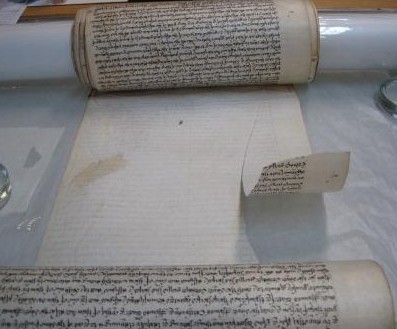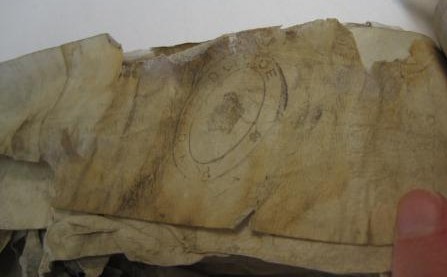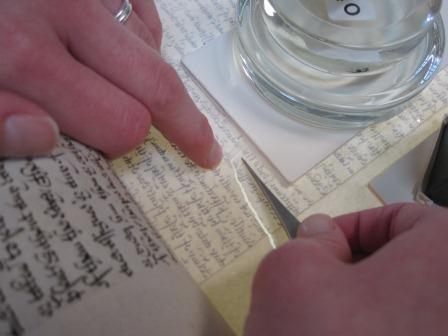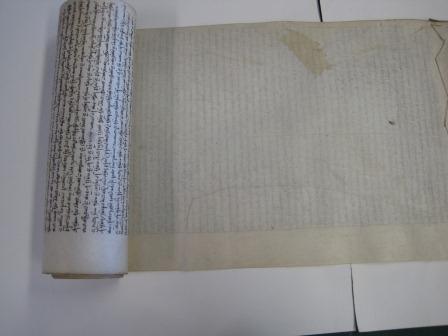A stitch in time saves nine: an apt phrase that sums up one of the major projects going on in our Collection Care department. It is called ‘Concept’ – CONservation Customer Enquiries Project Team – and consists of a number of conservators and conservation technicians responding to reports of damage, sent by readers or staff members to the Collection Care Enquiries inbox. The team meets every two weeks to discuss reported items and decide on a course of action.
The primary goal of the project is to stabilise damaged collection items where possible so they can be viewed in the reading rooms. We are never likely to be short of damaged documents but our resources are finite, so doing only what is necessary to make an item safe to be used is often the most economical use of our time. Conservation professionals call this approach ‘minimal intervention’, and it can have benefits other than saving time and resources. When taking such a cautious approach to intervening with the materials that make up an item, we are less likely to change or remove original material that could have historic value. It has become a guiding principle for the profession, changing the way we think about conservation in the long term.
As one of the conservators on the Concept team, I have worked on a wide range of items each requiring their own, tailored treatment. Over three blogs, I will share some of these with you, describing the treatments and some of the decision processes that led to them.
I will begin with my repair of a parchment roll. This particular roll is a Close roll from the Chancery and Supreme Court of Judicature and dates from 1611-1612.

Chancery and Supreme Court of Judicature: Close Rolls, Part 10 – parchment roll, before treatment (catalogue reference: C 54/2075)
Repairing a torn parchment roll
This was one of the simpler treatments I’ve carried out through Concept, because in general the parchment is in good condition: it’s very flexible and only with very small tears at the edges. However, one area had a large tear (as you can see in the photograph).
Parchment is widely thought to be a more robust material than paper, but in fact the reverse is true in many cases. Research [ref]1. Gavin Moorhead www.codexsinaiticus.org/en/project/conservation_parchment.aspx[/ref] has shown that even a small amount of moisture introduced to parchment can speed up the damaging oxidation of its collagen fibres. A process called gelatinisation happens when the fibres break down, which leaves the parchment stiff, sometimes yellowed and often translucent.

London receipts by Gautron de Bardes, master of the Mint. Discoloured and stiff parchment, likely to have been damaged through exposure to moisture (catalogue reference: E 122/71/2)
For this reason I used a repair technique that involves the least amount of moisture possible, while making the document strong enough to be handled without causing further damage. This method involves pre-coating a high quality Japanese paper with high grade gelatine adhesive. The adhesive is then reactivated using a pad moistened with a calculated volume of distilled water.
In this image you can see me applying a small, pre-coated strip of Japanese paper following the direction of the tear. I applied several of these along the curve of the tear and finished with a slightly heavier weight tissue at the outer edge to give the most strength to the weakest point. I positioned the repairs on the underside of the roll to avoid covering text.

During treatment: author pictured applying repair tissue
The treatment took two and half hours from start to finish, including:
- making the gelatine adhesive (we make adhesives ourselves, because pre-made solutions tend to contain preservatives and other additives that impact on the permanence of the product)
- preparing the repair tissue
- carrying out the repair
- documenting it for future reference
This was a simple and quick treatment, stabilising the damage while adding as little new material to the collection item as possible. This ‘stitch in time’ means the roll is once again ready for use in the reading rooms.

After treatment, tear is now repaired
In the next blog I will talk about my treatment of a book that had curled up into a tight roll.
[…] A stitch in time… […]